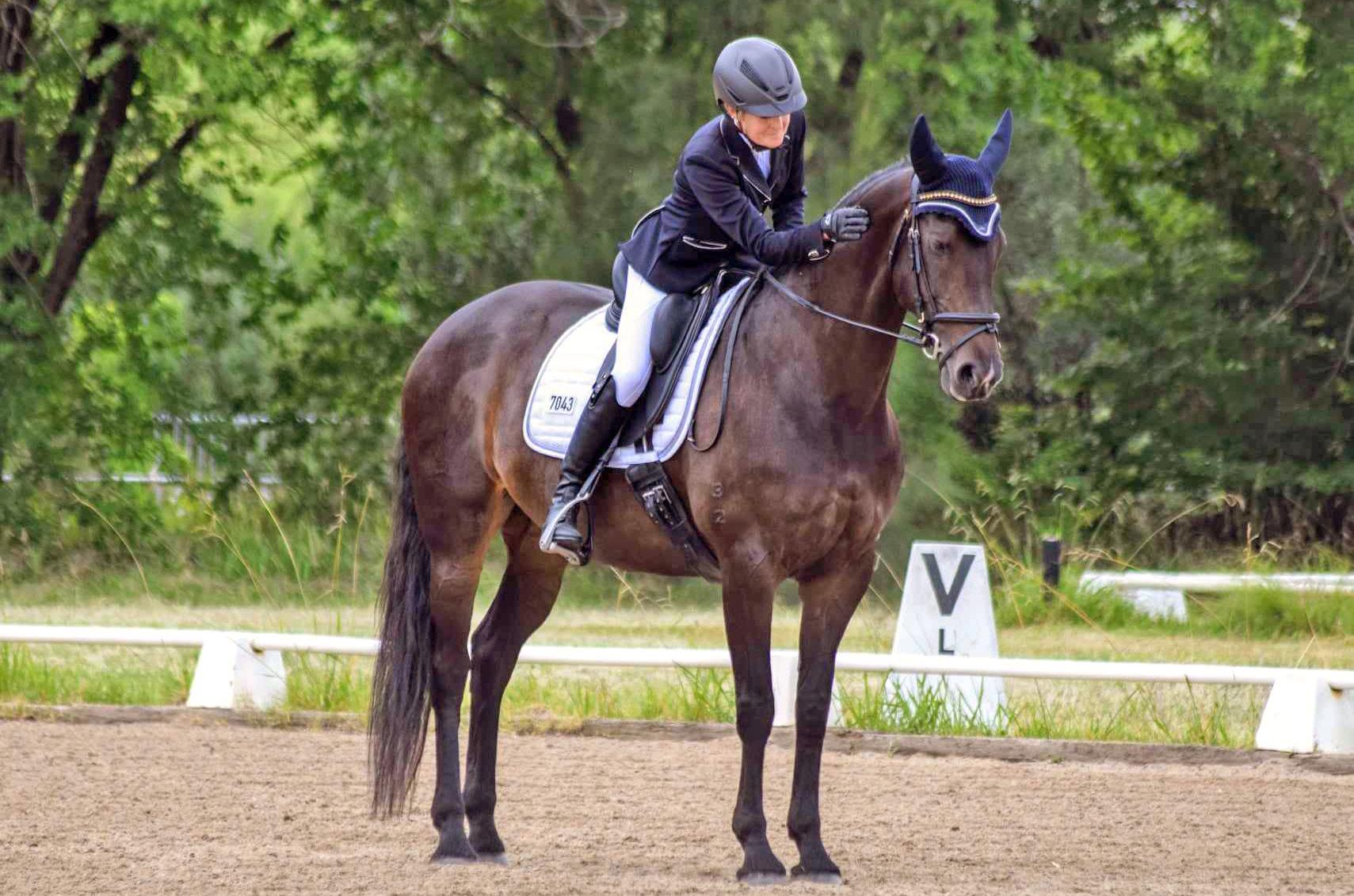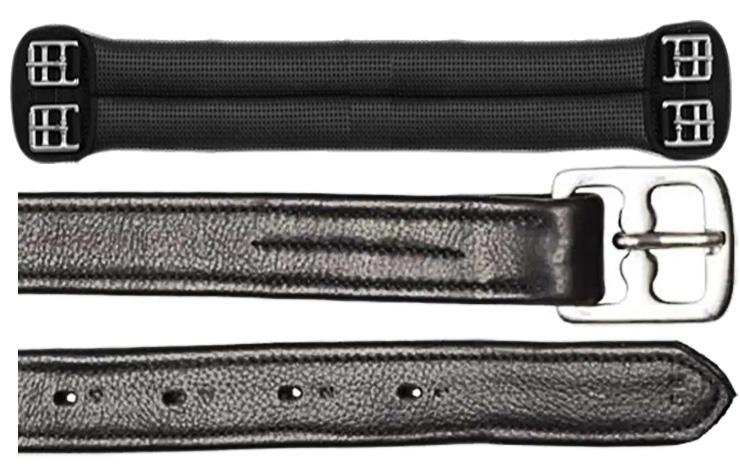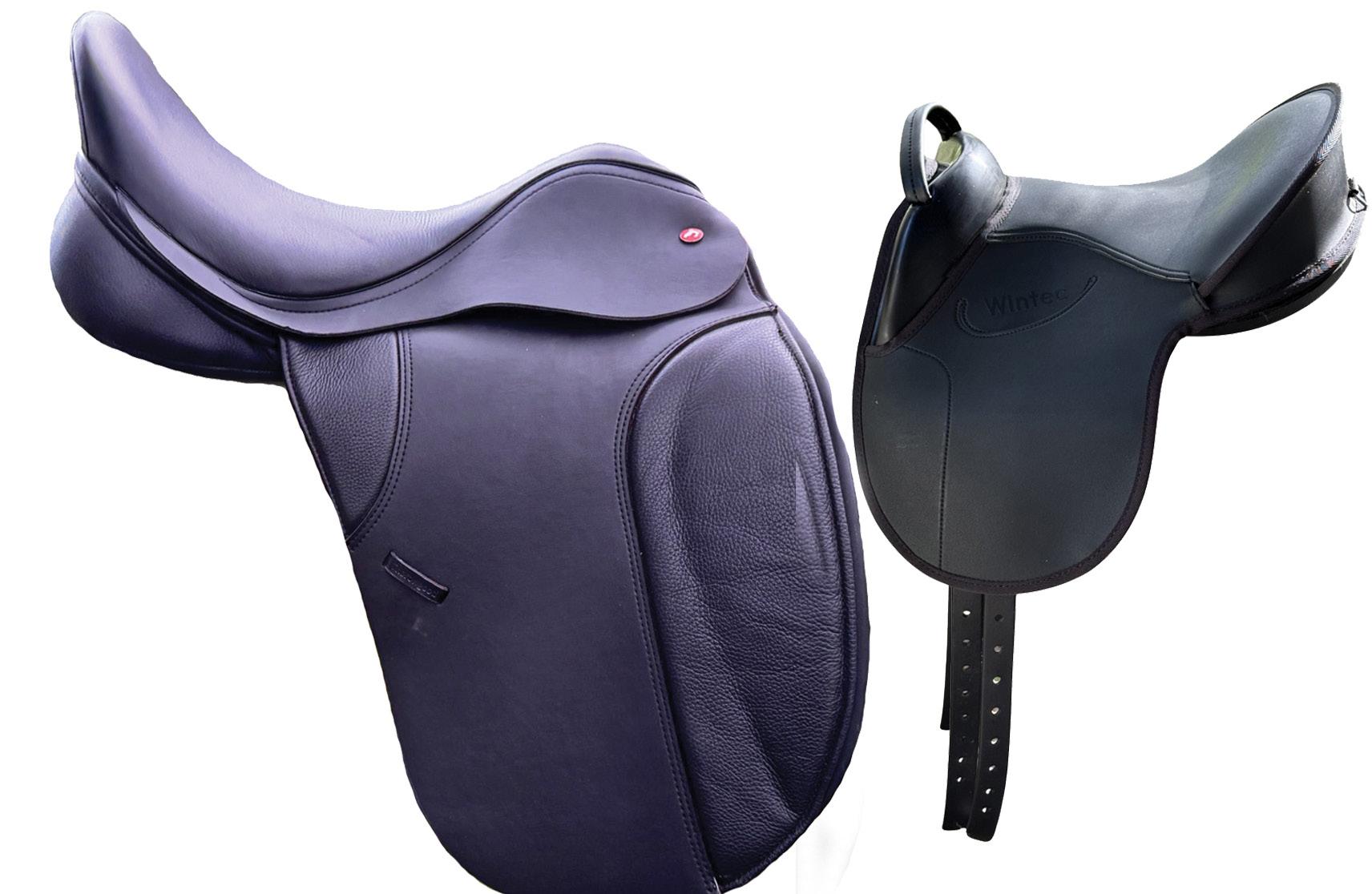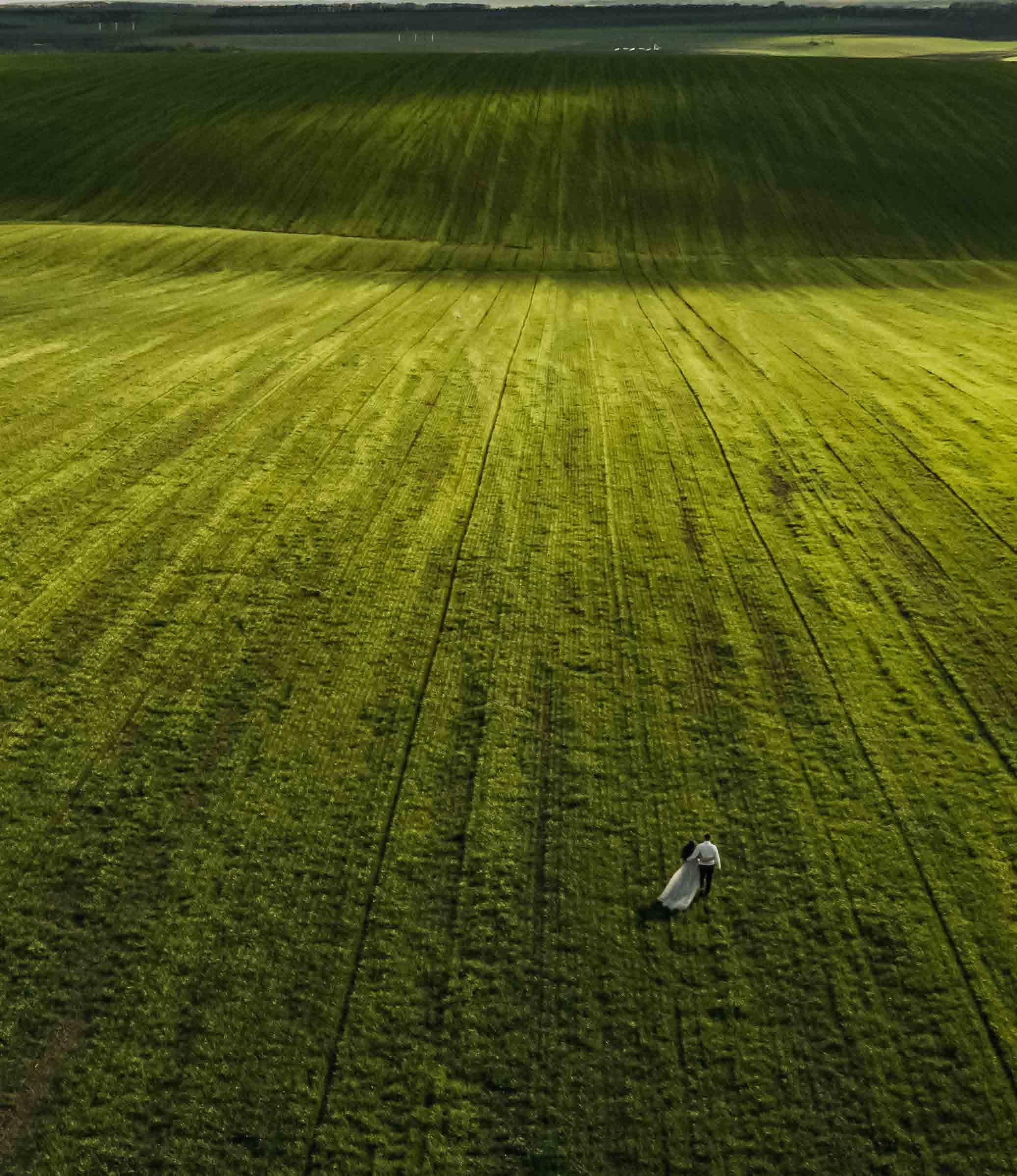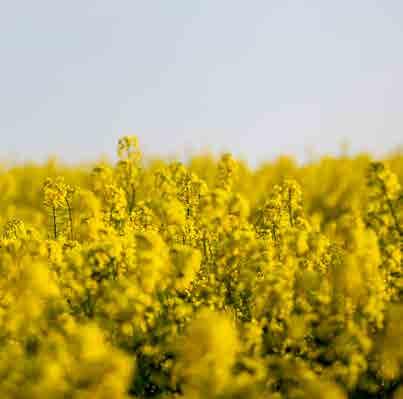
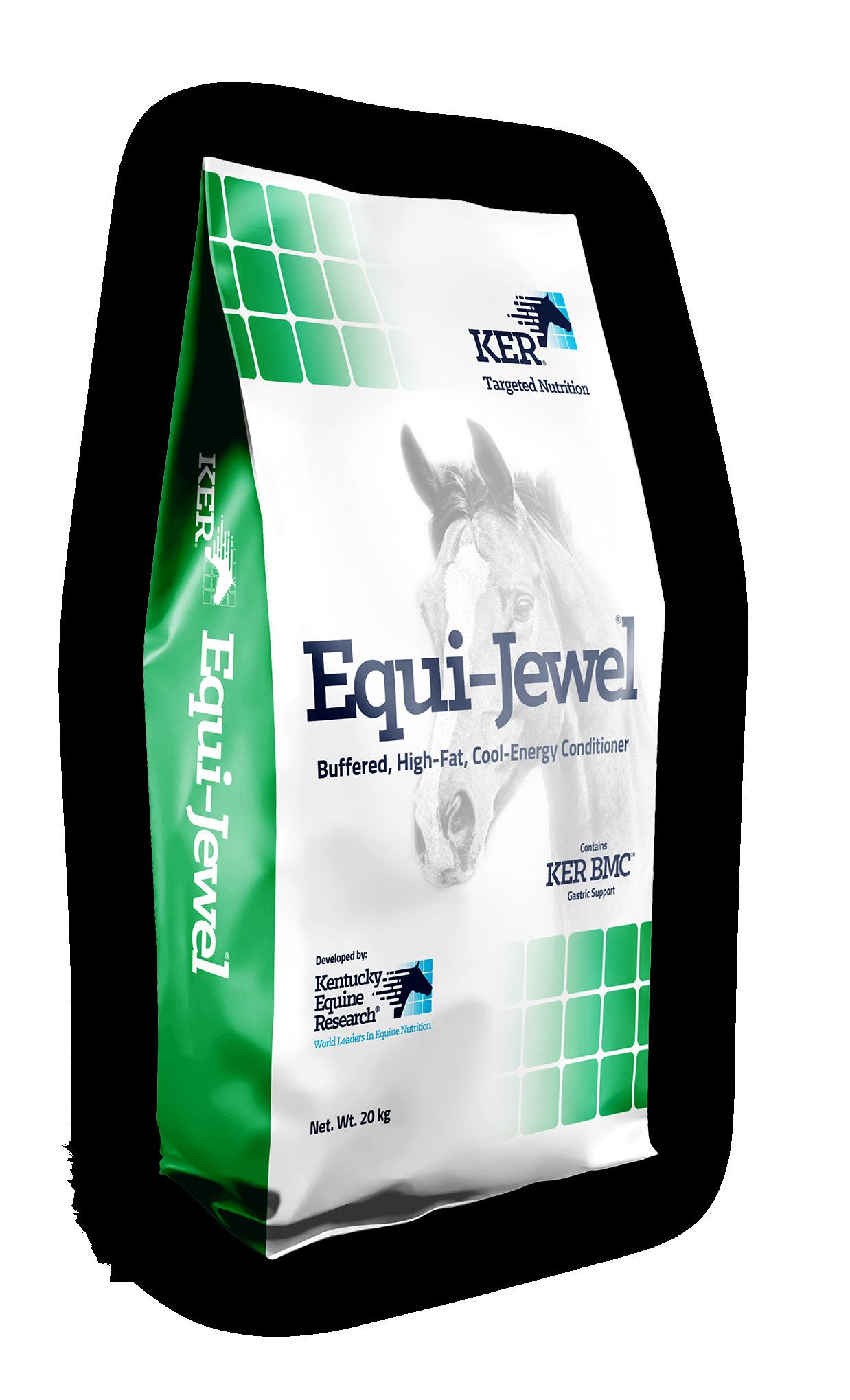




Equi-Jewel® is the ideal conditioning supplement to increase body condition, topline, and coat quality in breeding horses, performance horses, and horses being prepared for sale.
Equi-Jewel is a high-fat, cool-energy supplement that provides a safe source of calories for horses requiring a lowcarbohydrate diet or horses that are intolerant to grain due to tying-up or gastric ulcers.
Equi-Jewel contains KER BMC™, research proven to double the acid-buffering capacity of the stomach, which moderates stomach pH and reduces the risk of gastric ulcers. KER BMC also increases the buffering capacity of the hindgut by 54% to promote improved digestion and feed utilisation.
Learn more about Equi-Jewel at ker.com
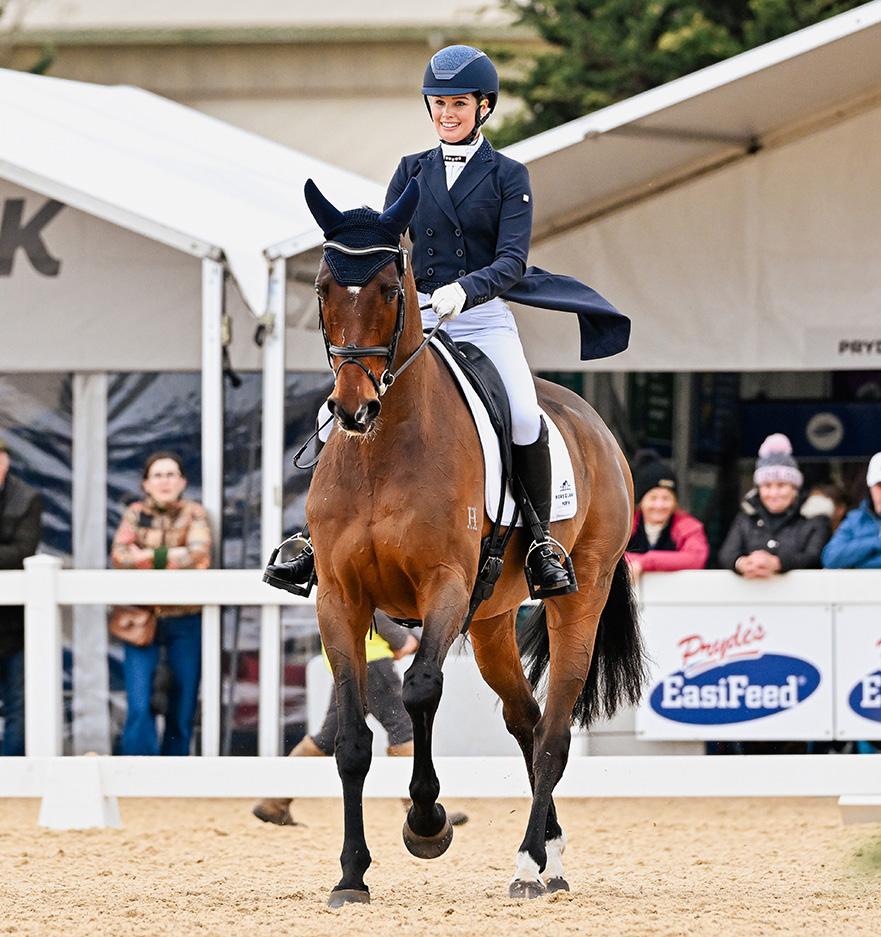
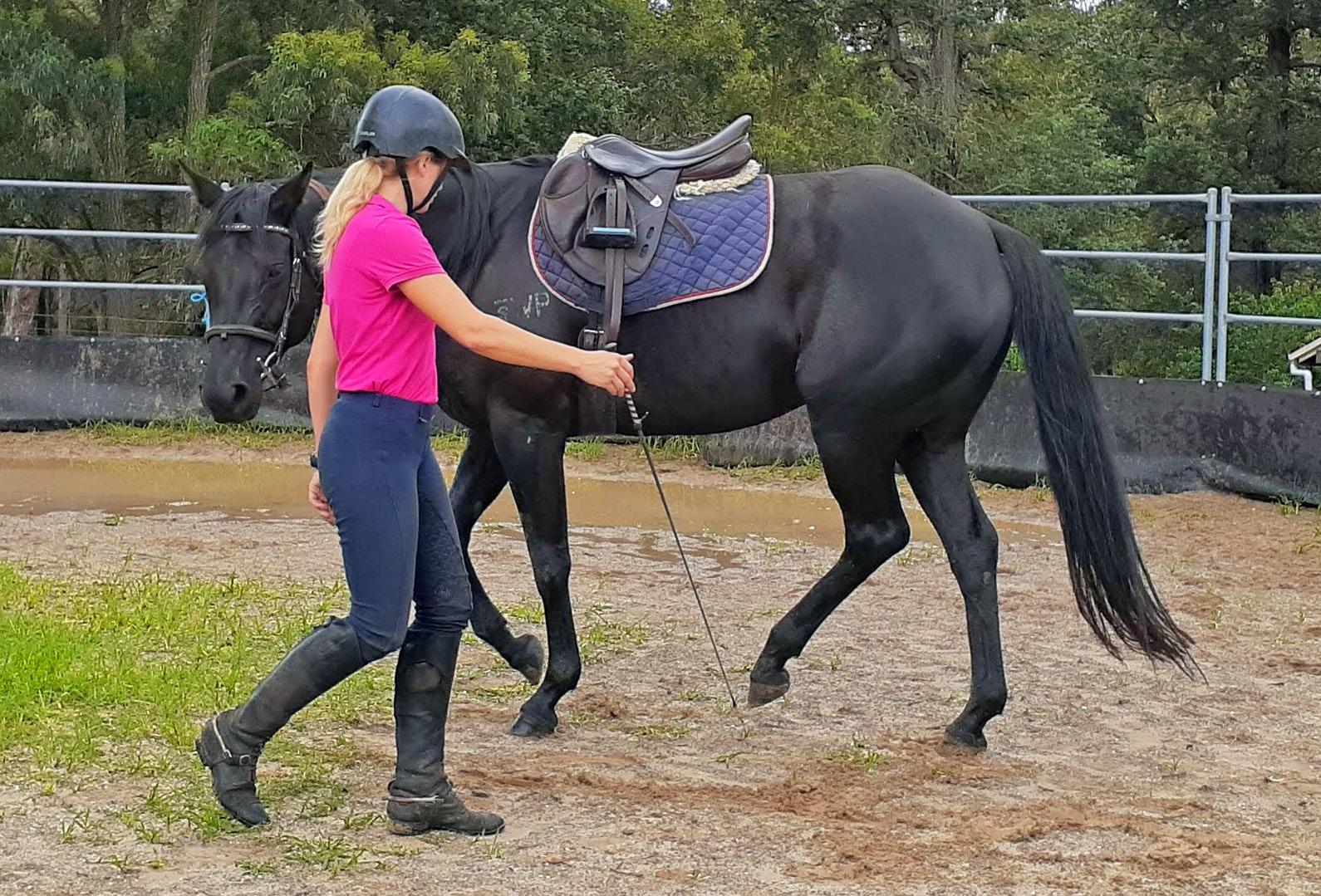


Editor Amanda McWhinnie
amanda@equestrianhub.com.au
Advertising
Fiona Todd 0414 760 067
fiona@equestrianhub.com.au
Website equestrianhub.com.au


Isobel Stevens-Menzie
When she's not busy creating comfortable and stylish interior designs, Isobel can usually be found with her off the track horses. She began riding as a small child and has been enjoying success in the discipline of eventing with her stunning OTT Azarax, who she bought as a 3-y-o and has been training up the levels to 3*. Isobel has the greatest respect for OTT horses and is a firm believer in their capacity to achieve great things.

Larissa Bilston B.AgrSc (Hons)
Amanda Mac
As editor of Equestrian Hub Magazine, Amanda’s two longstanding loves, one for horses the other for writing, come together perfectly. In this issue she speaks with Dr Oliver Liyou to find out more about equine dentistry and concerns around the declining numbers of equine veterinarians, before catching up with Isobel Stevens-Menzie, owner of the beautiful OTT Azarax.

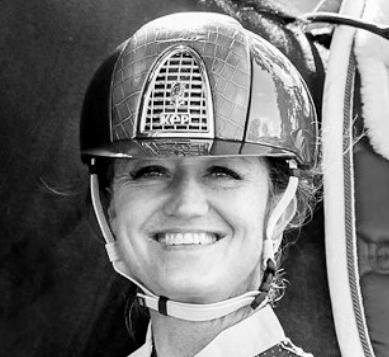
Christine Armishaw
Christine is a qualified EA Level 1 Coach and horse trainer who specialises in building confidence in women returning to riding and young riders getting started on their equestrian journey. Based at Otford Valley Equestrian, she runs clinics in NSW and NZ, and is a keen show jumper. In this issue, she explores the psychology of join-up, and its value in building your relationship with your horse.
Dr Jennifer Stewart B.V.Sc., B.Sc., Ph.D.
With over 40 years’ experience as a veterinarian in mixed and equine practice, Jennifer’s special interest is equine nutrition. She was a Senior Veterinary Officer with the Australian Department of Agriculture, Water and the Environment for 10 years, and a Biosecurity Veterinarian with the ACT Government for two years. In this issue, she discusses the many types of equine related viruses.
Larissa is the Equine Nutritionist for Farmalogic, where she developed Equine Vit&Min and the Farmalogic Equine range. Her extensive experience is highly regarded by trainers, riders and owners who understand the importance of good nutrition. In this issue, she discusses feeding horses through the extremes of Australia’s wild weather and the strategies that can help you cope.
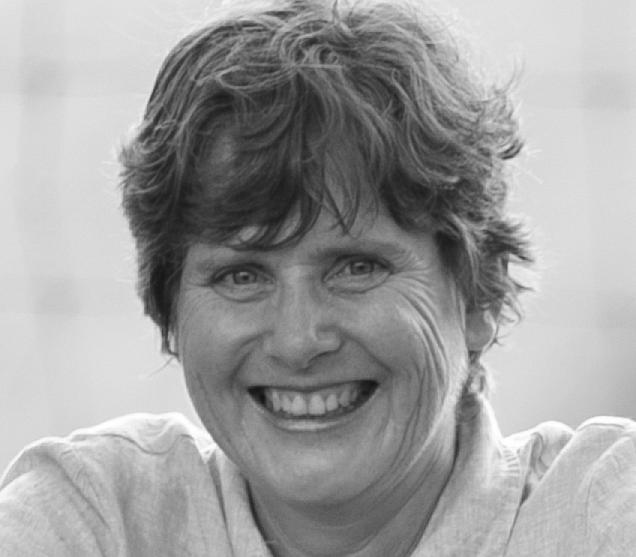
Nicole Tough
An EA Level 2 Dressage Specialist Coach and National A Level Judge, Nicole has over 30 years experience in training, competing, judging and coaching. She enjoys presenting seminars and masterclasses, has trained in Germany, Spain and The Netherlands, and has produced nine very successful FEI horses. This month, she unpacks behind the vertical - a hot topic in recent months.

Michelle Terlato
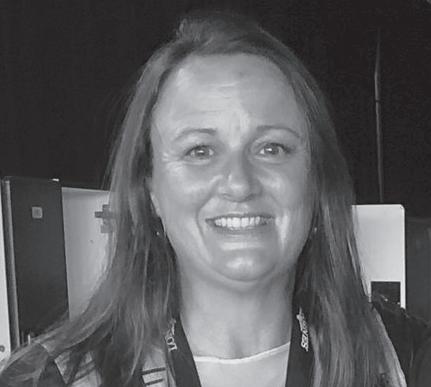
Dr Oliver Liyou B.V.Sc (Hons I), MANZCVS (EQ DENT)
Oliver is the principle veterinarian and owner of Equine Veterinary and Dental Services. Having grown up around horses, he has a passion for helping owners to help their horses and despite focussing on dentistry, enjoys all equine vet work. In this issue he discusses equine dentistry and the worrying decrease in the numbers of equine veterinarians.
Michelle grew up with horses and has always loved them. When she’s not travelling the globe photographing the world’s top equestrian athletes, she’s home riding her own horses. It’s the behind the scenes and the unexpected shots that she likes the best, and in our Behind the Shot feature, she shares her favourites and explains what makes them so special.



One of Australia’s top equestrian photographers, MICHELLE TERLATO travels the world capturing equestrian athletes in action.
Rider: Hazel Shannon
Horse: WillingaPark Clifford
Event: 2022 FEI World Eventing Championships
Location: Pratoni, Rome, Italy
Camera & Settings: Canon EOS-1D X Mark II, Canon EF 70-22mm f/2.8L IS II USM, f/2.8, ISO 200, 1/1250 sec
Challenges: The World Championships cross country course, set in the rolling hills of Pratoni near Frascati, Italy, was both long and hilly. One of the challenges with shooting cross country is ensuring you move around to avoid photographing every rider at the same fence. I was covering the Australian
Team for several publications, so I needed a variety of jumps and angles. I made my way up to ‘the slide’, a popular vantage point packed with spectators, for a shot of Shane and Virgil, hoping I would have enough time to hustle to another location for Hazel and Clifford.
I remembered there was a picnic table on a hill with a perfect view of Pratoni del Vivaro in the background. The only catch? There was only one fence there, so if Clifford didn’t jump it well or I missed the shot, I was in trouble! I also had to practically lie on the ground as they came through so as to frame the
village properly. I took a bit of a gamble and thankfully, it paid off. They jumped it beautifully, and I got the photos I needed. Why this shot is special: This image might not be the most dramatic shot I’ve ever taken, but it tells a story that sticks with me. Hazel and Clifford had an incredible cross country round that day, clear and under time. What I love about this photo is how everything comes together to capture the atmosphere of that moment and place. Hazel also purchased several of my images, always my reward when a rider likes them enough to want them.
In April I was in Adelaide for the 3DE where Hazel and Clifford made history by winning the 5* for the fourth time. It’s pretty special to have photographed them both at home in Australia and on the world stage. As Hazel says, Clifford is a legend - and I feel lucky to have been there to document part of that journey.

Michelle is available for event, commercial and private shoots. Visit Michelle Terlato Photography to view her impressive portfolio.


Behind the vertical is a topic that has attracted hot debate in recent times. NICOLE TOUGH looks deeper into what it is, and what it is not.
Our National Dressage Rules explain that in all work, even at the halt, the h orse must be on the bit. A horse is said to be on the bit, ‘when the neck is more or less raised and arched according to the stage of training and the extension or collection of the pace, accepting the bridle with a light and consistent, soft,
submissive contact. The head should remain in a steady position, as a rule slightly in front of the vertical, with a supple poll as the highest point of the neck, and no resistance should be offered to the rider’.
addition to other requirements, should be postured in this ideal position –which is quite difficult to ascertain and maintain. If we could all do it, we would, because everyone committed to their horse and the sport is working hard to achieve this ideal.
But even if the rider is seeking the ideal frame in the correct way, our horses offer many evasions to avoid this way of going because it requires willingness from an animal with a mind of their own, and it’s physically taxing.
As humans complain about going to the gym, so do our horses. Does this make the gym bad? No, going to the gym is actually very good for us, suppling and strengthening our bodies to be in fit and healthy condition, hopefully prolonging our lifespan.
However, in recent times ‘behind the vertical’ (BTV) has emerged as an area of hot debate, often being used to criticise riders and label their efforts as below average or even cruel. In fact, I often wonder whether BTV has been confused with rolkur, a controversial practice defined as ‘forcing the horse into an extremely deep posture for an extended period of time’. So, let’s unpack BTV, what it actually means, and why it might be deliberately or accidentally employed.
y where the horse is working more correctly over the back than it HANGING TOUGH
To score a 10 in any dressage movement or transition, the horse, in
The ideal position for a dressage horse is working on, or slightly in front of the vertical, with their nose aligned to an imaginary vertical line extending from the poll to the nose. BTV is when the nose is to some degree behind the imaginary line, and can be:
y an example of evasion
y a correction of another evasion
y evidence of a horse not in the right balance
y a contact fault caused by lack of rider core strength
y caused by misunderstanding
otherwise wants to
y where the rider can momentarily and more easily achieve self-carriage and/ or suppleness at the poll.
BTV is one of many contact faults. Others include:
y Leaning on the bit – the horse braces against the bit, pushing down on the reins and evading self-carriage
y Pulling and/or snatching – showing resistance to the restriction of the rein and instead of acceptance, pulling the riders hands into a position that suits the horse
y Above the bit – the horse carries their head too high, resisting contact
Additional faults to add to this list include being behind the bit, tossing the head, tilting, and tongue waving. Yet out of all these contact issues, BTV is the one that draws the most negative comment.
BTV first attracted attention in 1980 with the Olympic gold medallist Nicole Uphoff and Rembrandt. By all accounts, Rembrandt was a hot and spooky character, and inviting him to warm up in a less classical deeper frame, where he couldn’t see as much to spook at, proved a more productive and safer method of achieving relaxation and throughness. Once he was with his rider, he could be elevated to the ‘show frame’ and ridden softly, safely and correctly, scoring the world’s first 10s.
It is true that horses cannot see above their eyes. A spooky, tense horse will want to hold their head as high as possible increasing their range of sight; a serene horse will lower their neck and head with no need to scope their surroundings. A relaxed horse will happily graze, while a tense horse will be neck high, perhaps snorting with their body in a braced position poised for flight.
Dressage trainers may invite a tense horse, who may be rigid in the back or blocking flexion at the poll, into a lower BTV frame to achieve more looseness

LEFT: BTV shown in a moment while asking for Everdeen to come into super collection with increased engagement. You can see I’ve come out of position and am not using my core. Not an ideal frame, and the swish of the tail denotes Everdeen’s opinion! ABOVE: A more ideal frame shown a few strides later (Images by EK Photography).
and suppleness. They may even choose to compete the horse in this less than ideal position for a movement, knowing it will not score as well. Indeed, judges are obliged to deduct a mark when a movement is ridden BTV. If ‘all other requirements of the training scale are shown and the movement is ridden with fairly good accuracy’, the movement may attract a mark of 7 with 30% deducted for the less than ideal frame.
To counter evasion, dressage trainers may use methods in direct opposition to the evasion. This can be useful in developing athleticism. For example, if the horse wants to: lean, give them nothing to lean on; run, ride them slower; dawdle, ride them with more poweron; bury their head to evade being in balance on the haunches, ride them up; hollow to avoid connecting, ride them
deeper; be earthbound, ask them to be quicker off the ground; be too quick, ask them to be longer on the ground.
Similar to many other methods, BTV can be an example of incorrect training. But it can also be due to rider misunderstanding; or being deliberately used to promote relaxation or to push a horse through to correct another evasion; or the rider’s best effort to correctly connect their horse.
To be absolutely clear, let me conclude this article by saying that the point here is not in any way meant to justify BTV. Rather, it is to explain that dressage riding in the ideal position is not easy – and until we are getting 100% in dressage tests, we will always aspire to improve.

For more information on lessons or a clinic with Nicole, visit Nicole Tough


You've probably heard about join-up, and may have wondered if it was really worth the effort. It is - and CHRISTINE ARMISHAW explains why.
Join-up is essentially a trust exercise between you and your horse. Developed by the legendary American horseman Monty Roberts, joining up is a technique that gives your horse the choice between accepting you as a herd leader or not. The moment of join-up happens when the horse decides it’s better to be with you rather than to move away from you, and it can be achieved with horses of all types and ages.
But how does it work, and why is it worth doing?
Firstly, how does it work. Monty, known as the man who listens to horses, studied the way wild mustangs interacted with each other. He noticed that if a young horse was running amok and being a nuisance, an older horse, usually the boss mare, would drive them to the outside of the herd. Initially the youngster appeared unconcerned, rebellious even, until their survival
instinct kicked in and they realised being on the outside meant they were more vulnerable to predator attack. Additionally, rather than grazing happily in the middle of the herd, being made to move to the herd's outer edges was physically draining.
In join-up, we tap into this equine psychology and take on the energy of the boss mare. With our horse in the round yard, we shoo them away from where we’re standing in the centre, making them circle the yard and change direction with every few rotations. You may find your horse reacts with quite rapid movements, running, bucking and snorting – but that‘s nothing to worry about, because there’s a really important reason why we’re doing this. By mimicking the boss mare, and making the horse move their feet, we’re asserting ourselves as the leader, not in a domineering way, but similar to what the horse would experience within the hierarchy of the herd.
Eventually, your horse will decide that it’s hard work being pushed around and around the outside of the circle (and the magic number here seems to be seven minutes), and that they’d rather come

in and be with you. The reason they choose you is because you’ve created respect by making them move, and a horse feels security when they are told what to do in a confident way. By joining up, they’ve accepted you as someone they can trust to keep them safe.
The benefits of join-up are many, so yes, it really is worth doing. If I’m working with a horse for the first time, whether they’re a youngster or an older horse sent to me for training, I always start with join-up. That’s because I want to know how the horse thinks, how they process information, how long it takes them to do that processing, and whether or not they’re a bit reserved or little more rebellious. These are all things we can figure out from join-up, making it a really useful technique
And the value of joining up transfers to when you’re riding out on the trail or you’re doing something new and potentially spook-worthy. If you’ve put your horse in a situation where you’ve moved their feet and they have eventually chosen to join-up with you, they’re more likely to continue to trust you to make decisions for them because they recognise you as a good leader
The key to join-up is to be confident and decisive when you’re asking them to move around the yard. I’ve seen some riders, lovely, kind people who want to bond with their horses, who don’t want to be too bossy, or push the horse to move too much in case they won’t like them. But the end result is the opposite of the bond they were hoping to achieve! The horse decides their human doesn’t really know what they’re doing, can’t be trusted, and that they will have to look after themselves, which creates stress in the horse because now they have to watch out for predators and make decisions about where they think it’s safe to go next.
Often I’ll show a client how to join-up with their horse, but when it’s their turn to try, the horse just stands and looks at them instead of moving around the yard. Which brings me to an interesting point. It’s not about waving your arms around or making a lot of noise, it's all about the

ABOVE: If your horse follows you when you stop, turn, walk or jog, you’ve successfully joined up. LEFT: The boss mare leads the herd to feed and water, away from danger, and disciplines any unruly behaviour.
way you project your energy and the way that you make the horse feel as you move them around.
If you've been really forward and decisive when you’ve worked on join-up, even if the horse thinks there’s a tiger waiting somewhere on the trail, in much the same way that the herd trusts the boss mare to keep them safe, they're more likely to relax and trust you to let them know if there’s any real danger.
I had such an interesting case the other day. A lady who had returned to riding after 15 years away was having trouble picking up her horse’s back feet. The horse wasn’t trying to kick her, but kept snatching their foot away so she couldn’t hold it. However, the horse offered no resistance at all when I went to pick the foot up and gave it to me immediately.
Often this kind of behaviour is because the horse doesn’t respect you – and respect isn’t something you can demand, it’s there because you know how to project your ‘boss mare’ energy so the horse knows they can trust you to keep them safe and make good
decisions on their behalf. So, into the round yard we went to work on join-up. At first the lady couldn't move her horse properly - she fumbled around and the horse just stood and looked at her. But then she figured it out and after that one session in the round yard, there was a marked improvement when she tried picking up the hind feet – it wasn’t perfect, but it was definitely better.
It’s important to work on join-up as many times as you need, particularly if you’re building a partnership with a new horse, or if you’ve got a horse who’s determined to do their own thing! Join-up is a great groundwork tool that lets you focus on your bond with your horse, while making sure that you’re both on the same page. You get to see your horse from another perspective, and they get to see you from another perspective. I think it's a really good way of creating a different and deeper layer of relationship with your horse.

Christine Armishaw Equestrian offers a variety of coaching and other equestrian services at her Otford Valley Equestrian Agistment & Training Centre


The case of the vanishing vet
In this article, we look at two critical issues: the number of quasi-professionals offering equine dental services, and the rapidly declining numbers of equine vets.
Based in Grafton NSW, Dr Oliver Liyou has been a full-time veterinarian since graduating in 1993. He was employed in private practice for 10 years, before founding Equine Veterinary & Dental Services (EVDS), his equine-only clinic, in 2002.
Over the years, Oliver has employed more than 10 veterinarians in his rural clinic, and has delivered postgraduate training in equine dentistry to over
1,100 vets in over 60 equine dentistry workshops held across Australia. Now with more than 400 vets nationwide providing professional, quality dental care, he is moving closer to his goal of helping vets build sustainable, community-serving practices.
Knowing the equine veterinary profession as well as he does, there are a couple of things that Oliver finds deeply troubling: the first is the number
of semi-qualified practitioners who are offering cheap and nasty equine dental services; the other is the rapidly declining number of equine vets. And if you think that’s a problem only in Australia, think again – it’s worldwide. And the shocking suicide rate among vets? That’s a global problem too.
But first, let’s tackle the dentistry issue. Having observed the number of semiqualified people offering budget priced dental care for horses, Oliver wanted to address the problem, hence his mission to upskill vets though his much soughtafter equine dental workshops. “I’m strongly of the opinion that dentistry for horses needs to be performed by properly trained veterinarians. After getting only seven vets to our first workshop, we've turned it around massively, to the point where Australian vets offering equine dental services is now probably at one of the highest rates in developed countries, largely because of the workshops.”


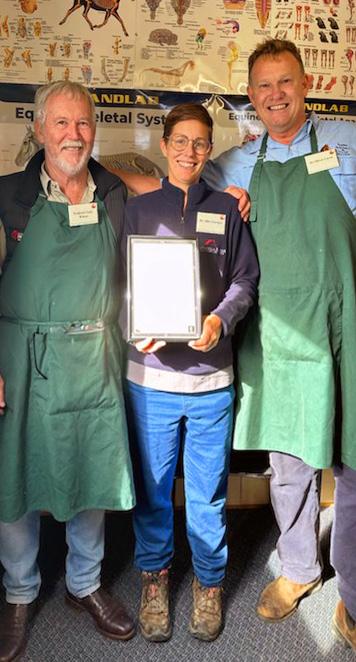
And Oliver has very good reason for insisting that equine dentistry should be offered only by veterinarians. “Horses require a thorough examination, both looking and feeling, to identify dental issues. Some problems you can see but not feel, others you can feel but not see. So often that means an x-ray is necessary, just as it is for us when we visit the dentist. Unfortunately, with many so-called practitioners, dental problems that need urgent attention aren’t picked up, and the horse just keeps eating. Even if they have a broken jaw, or a tooth root abscess, or if they’ve got pulp or nerve exposure, they're incredibly resilient and will just keep eating despite mouth pain.”
But that’s not the worst of it. There is little or no regulation around equine dental care being offered by quasiprofessionals. Yes, they may have completed a TAFE or similar course, but that in no way qualifies them to sedate a horse, or to extract a tooth - which, unless carried out by a vet is illegal
here in Australia. Nor do they have the equipment or the knowledge to properly diagnose and treat the dental problems your horse may be experiencing. So, if you genuinely care about your horse’s wellbeing, the ‘but they’re cheaper than the dental vet’ argument really doesn’t fly! Particularly when you consider that proper dental care costs the same as one to one-and-a-half cups of coffee per week per horse. Makes you think, doesn’t it.
But there’s something else that’s just as, if not more worrying, and that’s the problem of the vanishing vet. To be specific, we’re not talking about vets who treat cats, dogs and other small animals, safe to say their practices are usually flourishing – but the story is far from the same for equine veterinarians.
Let’s pause for a moment and consider a scenario in which your horse needs urgent medical attention, but there’s no one to answer your call for help. That’s a situation that none of us would like
to be in, yet unfortunately, it could be coming to a town near you in the very near future.
But what’s going on here? It’s an unwanted trend that Oliver has been trying to draw attention to for the past twenty years. “In the UK and US, it’s a similar scenario to Australia – and what’s happening is that it’s very hard to find vets to employ who want to work the hours, and the after-hours, when the reward for their time, effort, and the safety risks associated with tending to large animals is just not there.”
Oliver cites the example of a young vet he met recently at one of his workshops, who had been on call for 17 nights in a row, as well as being required to work her regular nine to five hours. That's a punishing schedule by anyone's standards. Then there’s the brilliant horse vet, a woman who Oliver graduated with, who has never had the time to have children and who is now utterly burned out by emergency calls.


And there’s this: “Some of the stories you hear from new graduates, and 90% of them are women, are that they’re fearful for their safety,” Oliver says. “They're going out to farms in the dark where there's no phone reception. They've never met the horse owner before, they could get kicked, they could get rapedit's just atrocious.”
Besides burn out, chronic stress and safety issues, there’s another horrific statistic that haunts the veterinarian profession, and that’s the suicide rate - which as Oliver points out, is a heartbreaking marker of how dysfunctional and grindingly hard the profession is. “I’ve lost eight veterinary friends to suicide in 31 years,” he says, which sadly shouldn’t come as a surprise when you consider vets have between two to four times the average rate of suicide. In fact, according to the President of the Australian Veterinarian Association, the problem is at crisis level (see ‘Valuing your vet’ in our Jan/Feb 2022 issue).
In Oliver’s opinion, much of these problems slate back to equine veterinary practices being screwed down by pressure from clients. “Everything has to be cheaper, faster, and more available. The clients of many equine vets have their mobile number and will text or ring them at all hours,” Oliver
explains. “Equine vet practices have built themselves on a model where they just keep delivering, giving so much that they end up burned out, with marriage breakdowns, all of that.”
Aware of the inherent problems, Oliver made a conscious decision not to offer emergency call outs when he started EVDS in 2002. “On two occasions I employed two other equine vets to cover emergencies, but both times it nearly sent the business under. Emergency work drains time and focus from doing elective services well, and it certainly would have stopped me from offering vet training courses. While I’ve felt guilt at times, I know this decision saved my career and postponed my exit from the profession.”
So, is there a way forward? Oliver believes there is, which is one of the motives underpinning his drive to educate vets in equine dentistry. “We have to have more elective work. Emergencies on their own represent five percent of your profit and ninety per cent of your stress. And yet, the horse industry largely thinks that vets are there for emergencies, and that they can call in a lay tooth rasper dentist for teeth. Dentistry is a massive part of the equation because it's the most common disease in all mammals, more so than anything else. My suggestion is that
the clients who use you for all of their elective work then qualify to have you come to an emergency for that horse. And I think until it all goes that way, nothing's going to change.”
Elective work is your vet’s bread and butter. It’s the work that subsidises wages, rent and electricity, as well as the financial commitment associated with insurance and expensive equipment. Being limited to mainly emergencies is not only stressful, it also has a much lower rate of success and thus client satisfaction, particularly when things don't go well and the client decides not to pay for the service they received. Inevitably, this means that to ensure the practice remains viable, the vet is forced to put up their fees, and the good people who pay end up subsidising those who do not.
Perhaps now’s the time to re-evaluate our relationship with our vets, who have devoted years to intensive study, whose lives are very far from easy, and who are burning out at an alarming rate. So, why not make the switch: have your trained vet care for your horse’s dental work as part of their overall health plan; don’t begrudge paying your vet bill; and appreciate your vet’s services - because there’s nothing sadder than not knowing what you’ve lost ´til it’s gone.

HARNESSING THE POWER OF SUNFLOWER SEEDS, AN ALL NATURAL SUPERFOO D

Omega Feeds has formulated a palatable, high fibre, low starch feed that contains a balanced blend of vitamins and minerals to ensure optimum health and vitality. No-Grain Gold is suitable for ponies, spellers and horses in light to medium work.
High Fibre: For gut health and cool energy.
Non Pelleted: Horses spend more time chewing which stimulates saliva production and in turn buffers the stomach and protects it from ulceration.
Low Starch: Reduced risk of digestive upsets and metabolic conditions.
Balanced blend of vitamins and minerals: For optimum health and vitality.
100% Australian, proudly supporting Australian farmers



EVENT REPORT
It's over for another year, but the 2025 Melbourne International 3DE made many happy memories for competitors and spectators alike.
Set against the iconic backdrop of Werribee Park, the 2025 Melbourne International Three Day Event once again proved itself to be one of the highlights on the Australian eventing calendar. It was an incredible five days of elite equestrian sport, as well as of heartfelt community spirit.
In a tribute to mental health awareness, riders were encouraged to add a touch of blue to their trot-up outfits in honour of Dolly Everett, who was lost to suicide after ongoing bullying, and the work of
Dolly’s Dream. The initiative served as a reminder of how important it is to be kind, and that bullying in the equestrian community and elsewhere is never OK.
In an exciting end to an action packed weekend, Niki Rose and Cooley All Over were crowned winners of the Off The Track CCI2-L*, finishing on 27.3 penalties. The pair led from start to finish, cementing their reputation as one of the country’s top CCI2*-L combinations. Right behind Niki was husband Shane Rose, who climbed from fourteenth
after dressage to finish 2nd on Limitless Lodge Zsa Zsa. Victoria’s Christopher Height and Royale Remington delivered the comeback of the weekend, leaping from 35th to 3rd with double clear performances.
The Godolphin Lifetime Care CCIJY2-L* was taken out by Victorian Lamoza Velisha and Call Me Cooley, who held their nerve in a nail-biting finish to secure top honours on 34.9 penalties. Just 0.1 behind them was Dominik Michalczyk and Fort Wirth, followed by Oliver Barrett and Tempranado in 3rd spot. Ella McCrum and Hez All That Jaz were named Best Performed Junior Rider in this class, finishing on a respectable 44.6 penalties.
Team New South Wales claimed the Teams Championship, with stand out performances from Niki and Shane Rose, Alex Rolton, and Bree Baker. In the 4CYTE CCI3-L*, Charlee MortonSharp and SV Supermaxi delivered a



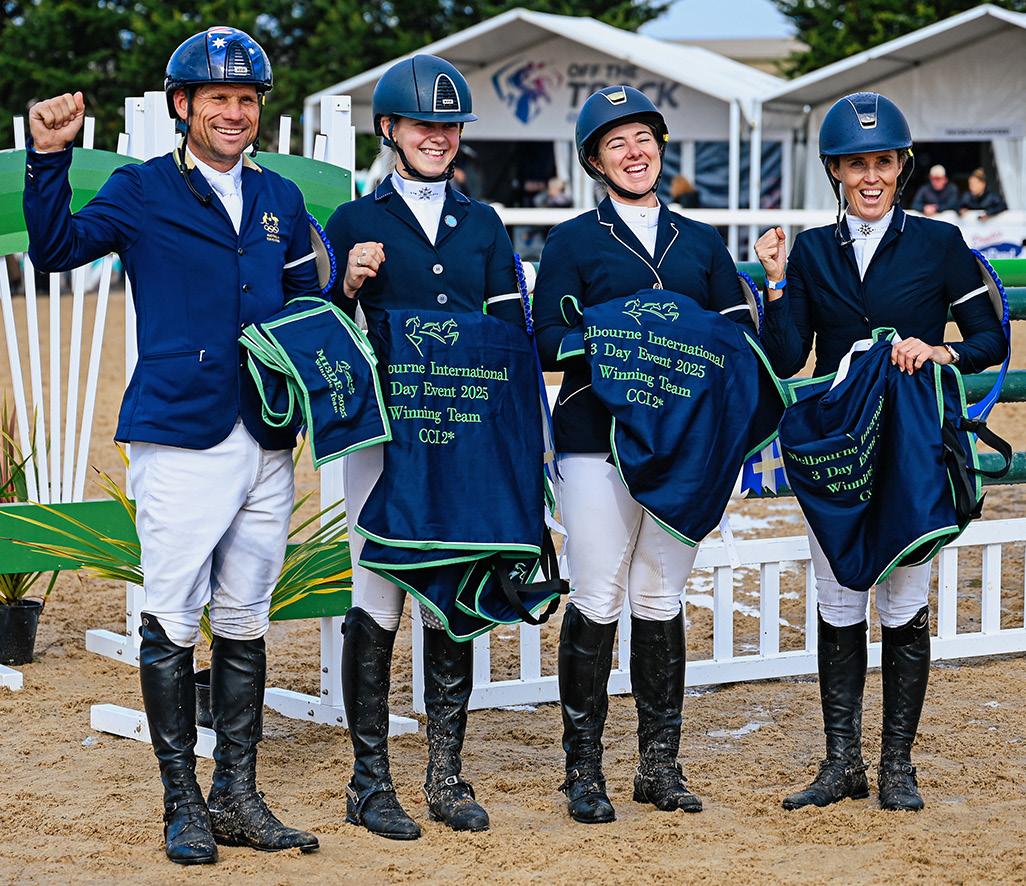
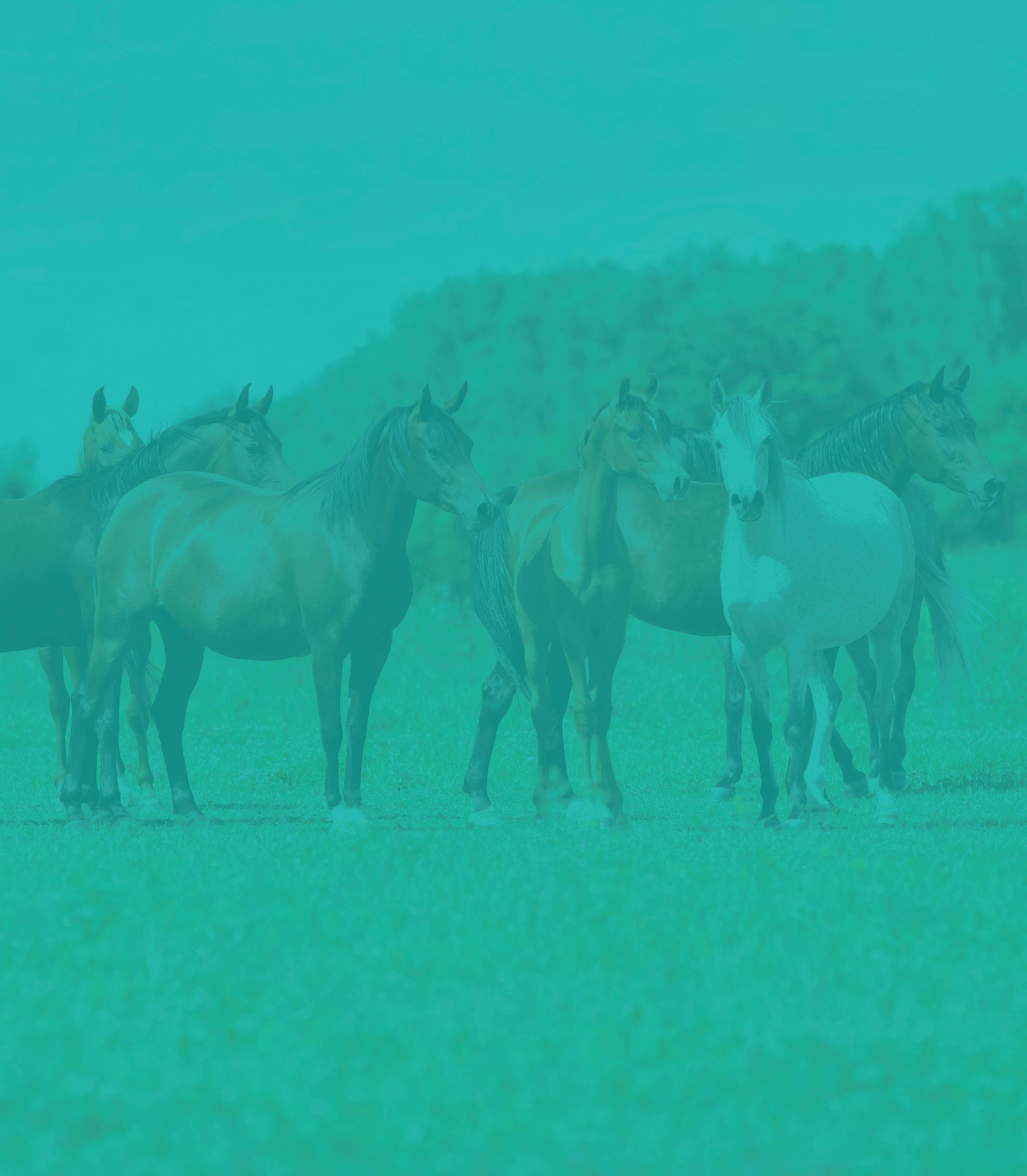
Apiam’s equine veterinary credentials are well-founded with a growing number of purpose-built dedicated Equine Vet Clinics and Referral Hospitals located in Victoria, New South Wales and Queensland, working alongside our network of mixed practice clinics in delivering quality equine veterinary care.

Scenic Rim Veterinary Service
Beaudesert QLD
Agnes Banks Equine Clinic
Agnes Banks NSW
Hunter Equine Centre
Scone NSW
Victorian Equine Group
Bendigo VIC
Gippsland Equine Hospital
Maffra VIC
Southwest Equine Veterinary Group
Warrnambool VIC
Find out more by visiting the Apiam Animal Health website & view the equine product range on Country Vet Animal Supplies





faultless jumping round to finish on 32.2 for the win. Charlee was also presented with the Best Performed Off The Track Thoroughbred and the Caitlyn Fischer Memorial Award, a touching tribute to a much-loved young rider who tragically died in 2016 after a cross country fall.
The prestigious Pryde’s EasiFeed CCI4-L* was won by Sophia Hill and Tulara Baltango, who soared from 7th after dressage to the podium’s top step on 42.4. Shane Rose capped off a busy weekend with a 2nd aboard Holy Moses, while Hannah Klep and Tulara Chicouve secured the 3rd berth.
In the Off The Track CCN1-L*, Marlene Battedou and Le Grand D Amour claimed victory after leading from start to finish. Charlie Richardson with VH Wingman, and Shashank Kataria and Tanoshi completed the podium line up.
The Gillian Rolton Award, presented to the Junior or Young Rider who finishes cross country closest to optimum time with no jumping penalties, this year went to dual winners Dominik Michalczyk with Fort Wirth (OTT) and Ruby Gorton with Blazing Django (OTT), who both clocked in at an identical time of 7:48.

Diary Date: Next year's MI3DE will be held from 4-8 June.

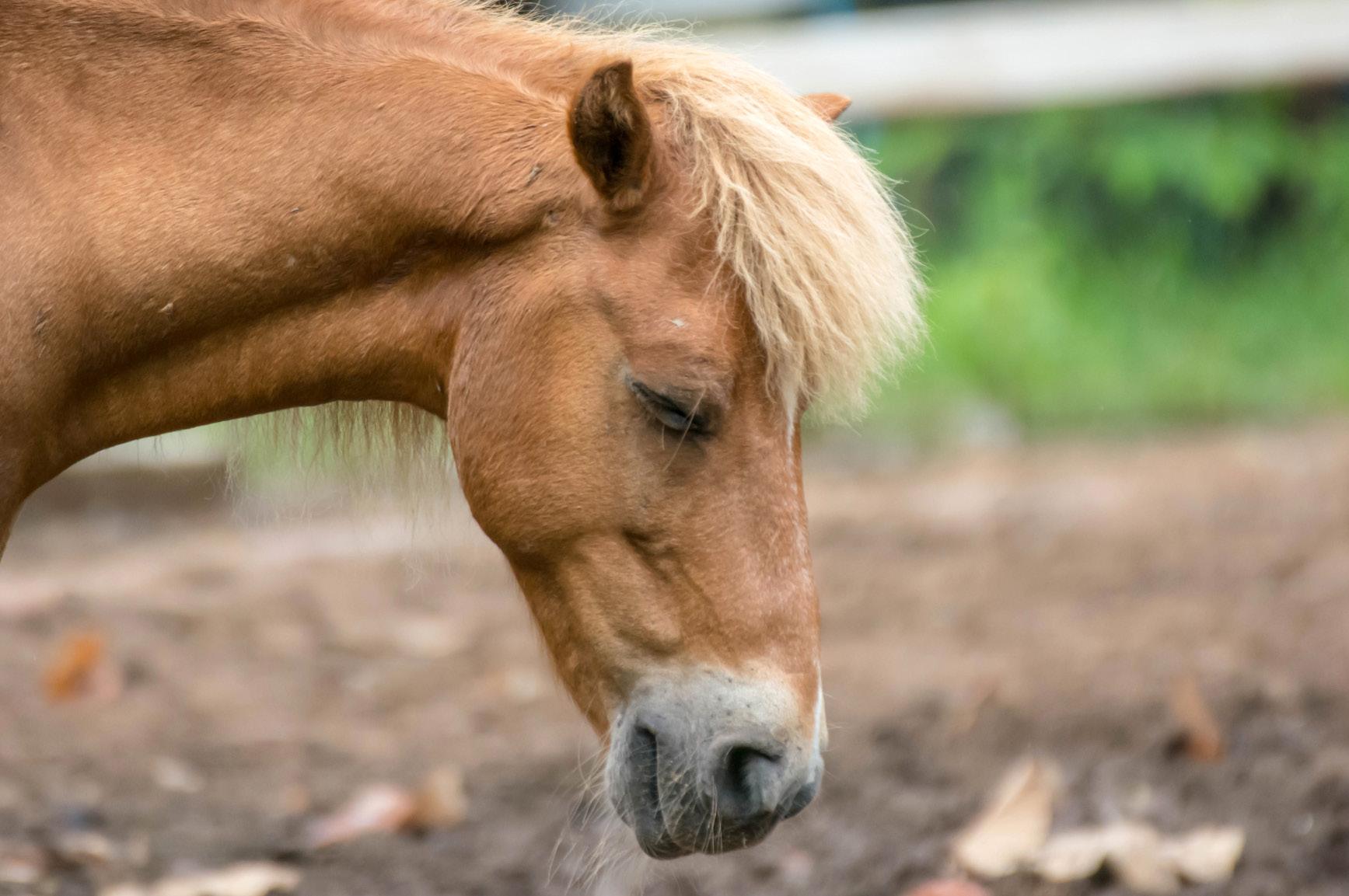

Horses can be infected by a number of viruses and if your horse is unwell, it’s a mistake to take it lightly.
DR JENNIFER STEWART offers her expert advice.
Does your horse cough during or after exercise? Do they have a nasal discharge? Or are they performing below the level you expect from them? If so, they may have a respiratory disease. Perhaps it's ‘The Virus’ - but if so, which one?
As the temperature drops and we move into winter, our horses may experience health conditions related to the change in season, one of the most common of which is respiratory disease. There are
many symptoms of respiratory disorders (Table 1) and as many causes, including infectious agents (bacteria, viruses or fungal spores), inflammation due to exposure to dust or other toxins in the air, and parasites. Bacteria often take hold in young, stressed or immune compromised horses, and viral infections can cause disease and create conditions for a secondary bacterial infection.
Respiratory issues can be infectious or non-infectious, but they can be
interrelated, coexist, and combine to increase the risk, occurrence and severity of disease. Equine asthma is the major non-infectious respiratory disease of the lower airways. Triggered by inhaled environmental allergens such as dust and fungal spores, which irritate the airways, it results in hypersensitivity, constriction and mucus secretion. It is usually a chronic disease with a slow onset, but acute episodes do occur. Also known as RAO (Recurrent Airway Obstruction), COPD (Chronic Obstructive Pulmonary Disease) or IAD (Inflammatory Airway Disease), 25 to 80 per cent of stabled horses suffer from equine asthma to some degree.
World-wide, at least 58 viruses are known to infect horses. The common respiratory viruses include equine herpesvirus-1 and herpesvirus-4 (EHV -1 and -4), equine influenza virus (EI), equine arteritis virus (EAV) and adenovirus. In Australia, the common viruses are EHV-1, EHV-4 and equine rhinitis virus (ERV). Once infected, the herpes virus remains with the horse

for ever. When stressed or suffering a respiratory infection, symptoms of herpes may reappear or the horse may remain symptom-free but shed the virus, thus exposing other horses. A horse can be infected with multiple herpesvirus species, which can result in immunosuppression and increased susceptibility to new or reactivated infections. Reactivation and shedding of EHV is often associated with transport and travel and can continue for over two weeks after a journey. Furthermore, concurrent EHV infections play a role in reactivation of latent infections, predisposing foals to the potentially fatal ‘rattles’ infection with Rhodococcus equi bacteria.
Herpesviruses generally cause a mild nasal discharge. However, in foals and aged horses herpes can produce a flu-like illness with fever and cough, neurological disease (mild incoordination, loss of bladder and tail control, skin desensitisation around the vulval area), and abortion. Over 85% of horses test positive to exposure to herpes. Due to the risk of abortion, as well as illness and death in young foals, it’s particularly problematic for stud farms, which may choose to make vaccination mandatory for visiting mares.
Another cause of respiratory and neurological disease is Hendra virus. Since it was first identified in 1994, there have been over 100 confirmed or probable equine cases, all of which died or were euthanised, and seven known cases of Hendra virus infection in humans, four of which were fatal. Hendra is challenging to diagnose in the field as the signs are non-specific: a fever, lethargy and depression. The progression to respiratory and neurological disease is usually rapid and may result in watery or frothy, blood-tinged or brown, nasal and/ or oral discharge.
Strangles, another cause of infectious respiratory disease, produces a thick, yellowish discharge. Caused by the Streptococcus equi bacteria, strangles
Table 1: Symptoms of respiratory disease – either singly or in combination.
Nasal discharge, from one or both nostrils
Nose bleeds
Nostril flaring
Dullness, depression or loss of appetite
Increased respiratory rate (normal 8-15 breaths/min)
Increased effort of breathing
Facial swelling
Bad breath - halitosis
Unusual sounds at rest or while working
Coughing
Exercise intolerance or reduced capacity
Fever - more common with infectious causes of respiratory disease
in highly contagious and spread by discharge from the nostrils or pus from burst abscesses. Signs include depression, fever and loss of appetite. Veterinary monitoring is helpful as at least 10% of horses infected with strangles will end up with chronic infections in their guttural pouches. Horses can carry bacteria in the pouch for months after they have recovered, and although they appear clinically well and healthy with no signs of infection, they shed bacteria in nasal discharges and are a source of infection for other susceptible horses.
In foals, a discharge from both nostrils is common with infections acquired before, during or soon after birth: meconium aspiration; a herpes virus infection; or with rattles or pneumonia in older foals. Recently on some studs in Australia and overseas, Chlamydia psittaci a zoonotic pathogen carried by birds, has caused pneumonia in vets, horses and farmers; a serous nasal discharge in adult horses; premature birth and abortions in mares, and acute respiratory distress with nasal discharge in new-born foals. Biosecurity and personal protective equipment is needed when dealing with Chlamydiaassociated respiratory disease.
Several gastrointestinal parasites can also be a problem in foals and young horses. Roundworms (ascarids) are a danger to
horses from two months to four years old – partly due to increasing resistance to common wormers. The larvae of roundworms migrate through the lung tissue and occupy the airways, causing a nasal discharge which may contain worms. Once lung tissue is damaged by the roundworms, viral or bacterial infections can occur. Threadworms (strongyloides) can also cause respiratory signs and a nasal discharge when they enter through the skin and migrate to the lungs. Horses paddocked with donkeys can become infested with a lungworm (dictyocaulus), which spends its adult life in the lungs, laying eggs that are coughed up, swallowed, and then passed in the manure.
Viruses remain the most important cause of serious respiratory disease in adult horses and foals worldwide. Fundamental players in the history of life, their own ancient evolutionary history has remained largely unchanged over billions of years. The best estimate of the number of virus particles on earth today is close to 1031 i.e. 10x10 31 times. The smallest of all microbes (it would take 500 million rhinoviruses, the cause of the human common cold to cover the head of a pin) viruses can only exist by hijacking the cellular machinery of another living thing in order to reproduce.


Viruses cannot replicate on their own. They bind to the host cell and merge with the cell wall. Once they’ve invaded the host cell a steeplechase begins as they quickly shed their outer coat, bare their genes, inject their DNA and hijack the cell to reproduce viral DNA (Figure 1), ultimately exploding out of the cell in the form of new virions (virus particles) that infect other cells as they invade the body. During a viral infection there can be several million virions in every millilitre of blood.
The body’s cells are able to use antibodies to detect and destroy viruses. They bind to the virus like a lock and key, marking them as invaders. Each antibody producing cell can produce 2,000 antibody molecules per second, and within seven days, antibodies are detectable in the blood.
Vaccinations combined with sound biosecurity practices can lower the risk of viral infections. Vaccination is a process by which we stimulate the immune system to produce a defence mechanism against selected diseases. In Australia, we can vaccinate our horses against tetanus, strangles, EHV, salmonella, rotovirus, and Hendra. Most of these vaccines are given depending on a risk assessment of the horse and may apply to breeding horses specifically. There is no standard vaccination program for horses, instead they should be designed after considering all risk factors
and regulations. Directives regarding vaccination status may apply to horses participating in competitions and it’s important to check the policies of both the organisation and the venue.
During the last decade, the emergence of Hendra virus and the incursion of equine influenza have heightened the value of horse biosecurity practices. Prevention is without a doubt the best defence and many steps can be taken to lower the risk of respiratory diseases. Vaccinating against common viruses should reduce the incidence of these pathogens in your herd. Without these viruses, secondary bacterial disease is also a lot less likely.
Quarantining new horses before introduction to the rest of the herd helps prevent the introduction of any unwanted pathogens to otherwise healthy horses. Keeping horses divided according to age group can also help as many pathogens can be passed to younger horses by older horses with better developed immunity. For horses with inflammatory airway disease resulting from allergies, ventilation is key to improving their health. Often these horses do better if turned out to pasture due to improvement in air quality and more time spent with their head down grazing, which helps with the expulsion of the dust, toxins and mucus in their airways.
We are lucky here in Australia compared to many other countries as EI is not present, but there are other contagious
respiratory diseases. By applying basic biosecurity measures - avoiding potential contamination of feed, water and equipment; insect and animal disease vector control; good hygiene when handling horses; and isolation of sick horses from healthy ones – we can help reduce infection. It’s also advisable to keep horses new to a yard, or those returning from competition, separate/ quarantined for a period of time.
Although no vaccination can guarantee 100% immunity – and owners should always monitor their horses for signs of disease – there are vaccinations for tetanus, viral respiratory disease and strangles, and your vet can advise you on what your horse should be vaccinated for and how often (vaccination programs will differ for individual horses and situations). However, in a stud situation a complete vaccination program for tetanus, strangles, EHV and salmonella is recommended.
While there are no guarantees, there are many things you can do to reduce the incidence of respiratory diseaseincluding vaccination, biosecurity and air hygiene.
Immune system support
Vitamin E is abundant in fresh grass, but declines rapidly after cutting and baling to make hay. Horses with little or no grass have extremely low levels of vitamin E and along with selenium, these are two of the most important and
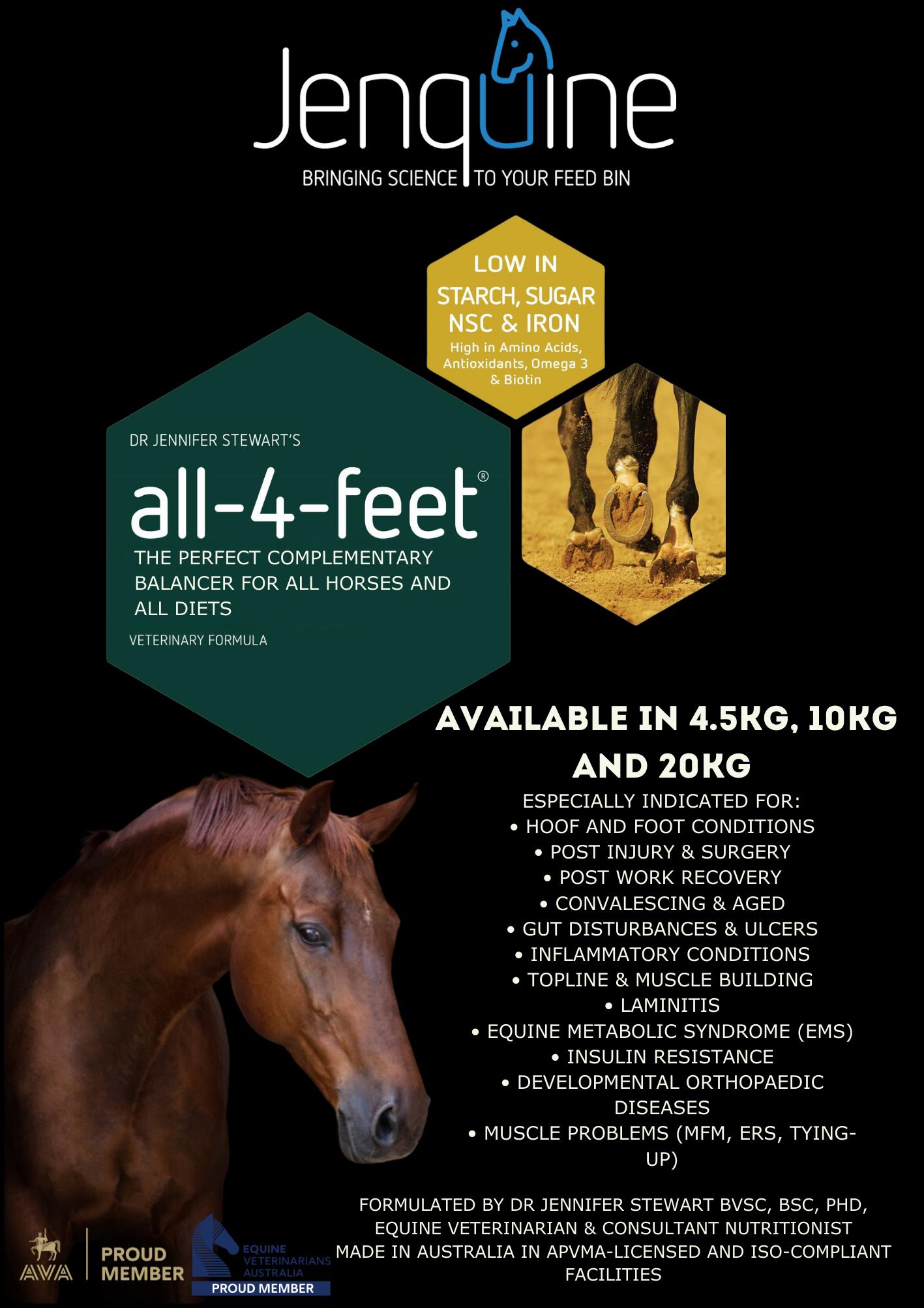



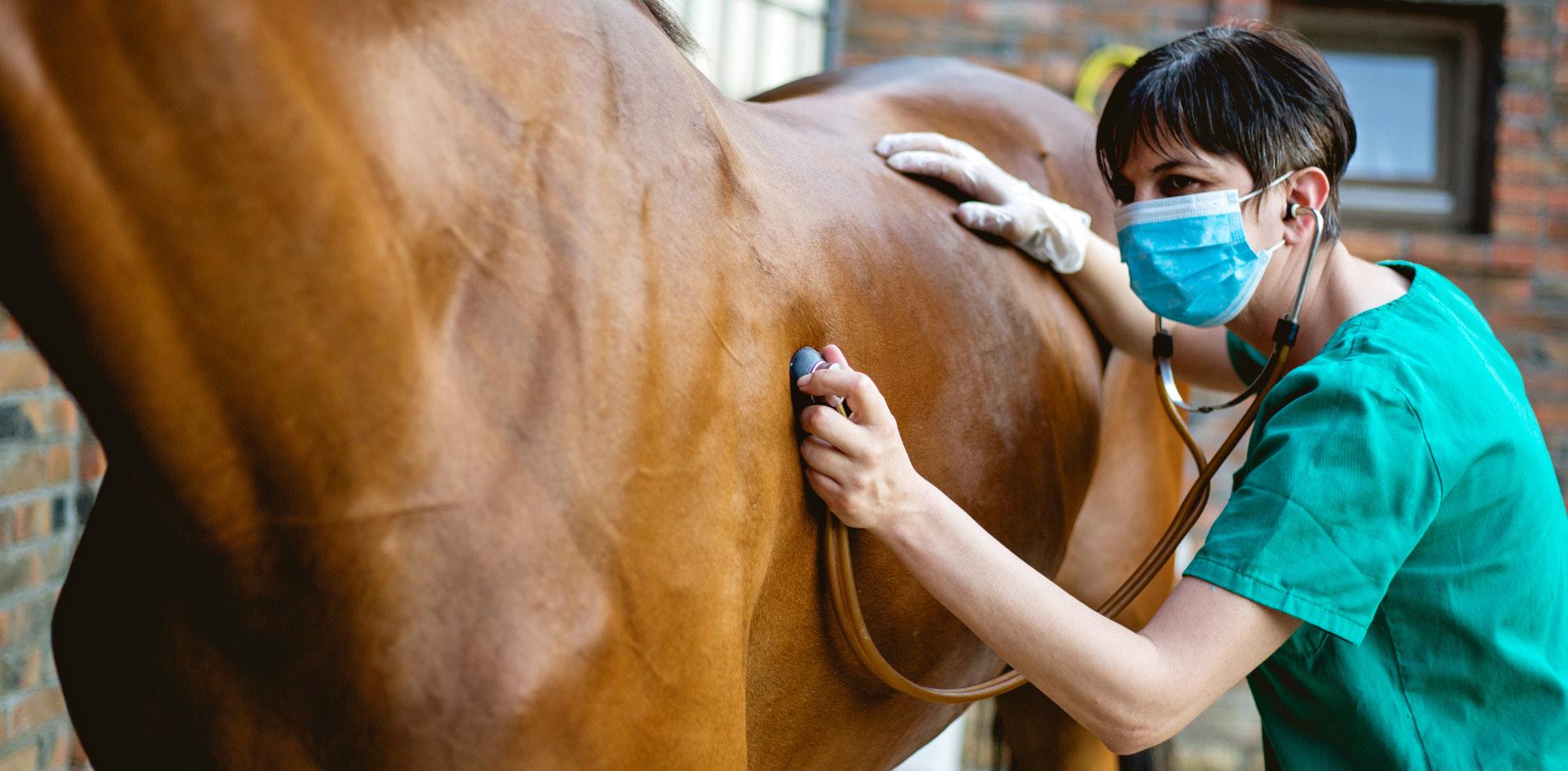
often deficient nutrients. For an average horse (400-500kg) the basic vitamin E requirement is 1000iu/day and 2000iu for immune system support. Fresh grass is a rich source of omega-3 essential fatty acids, but these too are lost during cutting and baling. Linseed and chia seeds are excellent sources of omega-3 and the average horse will benefit from 100-200g/day or 125–250ml of linseed oil. There is no doubt that vitamin C is a central pillar in health and fresh grass is a rich source, but blood levels fall in winter on hay diets. Most mammals produce vitamin C from glucose, it can’t however, be stored in the body. There’s much we don’t know about vitamin C in horses and whether supply exceeds demand with age, injury, infection, musculoskeletal conditions or wounds. High doses (20g/day) can cause gut irritation and diarrhoea and extra caution is needed in horses with insulin resistance or iron overload. As a rule of thumb, 10grams/day can support the anti-oxidant defence system, but the diet must be balanced first.
The resurgence of certain viruses is caused, among other things, by the growth of international equine movement for breeding and sport events, as well as
expansion in the geographic distribution of viral pathogens.
The majority of viral outbreaks associated with respiratory disease in horses occur in winter. Dry, cold air affects the local defensive mechanisms of the airways and increases susceptibility to irritants and infective pathogens that gain entry via the respiratory tract. During winter months, horses are more likely to be indoors and due to dust, fungal spores, bacteria, endotoxins and viruses that horses can inhale, air quality in stables and barns is poorer than outside. Horses who are housed are also often in closer contact to other horses, and this can increase the spread of airborne pathogens. If you notice your horse begins to cough more when they are brought inside or when there is increased dust or other particles in the air, it may mean they have an inflammatory airway disease. If multiple horses are coughing it may be a sign that there is a virus circulating. Determining the cause requires a full veterinary clinical examination and often additional investigations.
Horses that are well and healthy may produce a small amount of clear, watery nasal discharge after exercise - that little trickle at the end of the ride or after a
long trip in the trailer that goes away without a second thought. However, in the case of a suspected respiratory disease, a veterinary evaluation is advisable to determine the possible cause, and the appropriate treatment and management. The examination may include a nasopharyngeal swab; endoscopy; and guttural pouch, tracheal and lung washes. The treatment is usually a combination of management strategies and medications, depending on the cause of the respiratory disease and the infectious agent (if any) involved.
Most routine respiratory cases resolve with minimal treatment and no permanent damage. With others, it’s a mistake to take them lightly and timely veterinary intervention is needed for the best outcome.

Dr Jennifer Stewart BVSc BSc PhD is an equine veterinarian, a member of the Australian Veterinary Association and Equine Veterinarians Australia, CEO of Jenquine and a consultant nutritionist in Equine Clinical Nutrition.
All content provided in this article is for general use and information only and does not constitute advice or a veterinary opinion. It is not intended as specific medical advice or opinion and should not be relied on in place of consultation with your equine veterinarian.
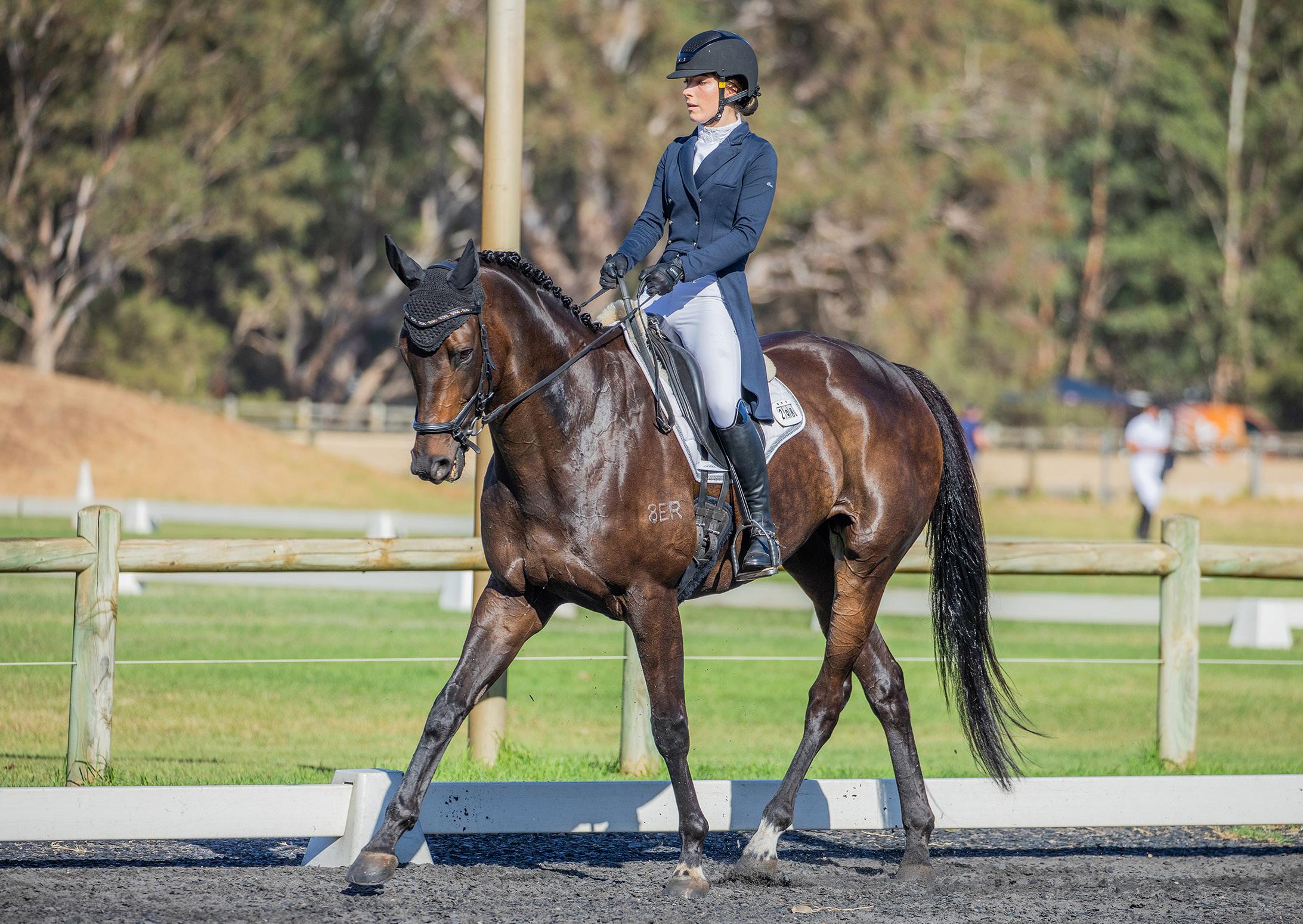

Not all horses bred for the racetrack have a successful career. But when they retire and find a sport they love, they shine, writes AMANDA MAC. LIFE AFTER RACING
If you’ve been reading our Life After Racing features for any length of time, you may have noticed how often Thoroughbreds with impeccable pedigrees, and bred with the highest expectations, show absolutely no interest or aptitude for the Sport of Kings. However, once they move on to their off the track career, their light often begins to shine very brightly indeed.
And staying true to that form is Azarax (Distribute). Foaled in Australia in 2014, he was sired by Blackfriars (AUS) out of Bermaise (AUS), but after a much anticipated racing career fell flat, he was retired as a three-year-old, which is when he was purchased by Isobel Stevens-Menzie.
Based in Western Australia, Isobel began her riding career as a very
young child. With a mother who had grown up with horses in her family, and a granddad who was an enthusiastic equestrian, it comes as no surprise that when Isobel arrived, there was a pony ready and waiting for her. “I have photos of me at an age when I would have barely been able to walk, sitting on a tiny little pony and being led around by my parents.”
Later came Pony Club, where Isobel discovered she excelled at mounted games, because, she says, she had a pony who was equally enthusiastic. However, she also loved cross country, and by the time her Pony Club days came to an end, she was taking lessons and becoming serious about competing in eventing. “I remember doing my first competition as soon as I was old enough to compete. It was annoying to have to wait because I was too young, but once I got into it, I became more and more serious about the sport.”

ABOVE: Showing plenty of scope over the 3* box at Capel CCN in 2024 (Image by Wayne Edwards of Waylib Photos).
LEFT: Sand dancing for the win at WAYER last year (Image by TinCan Imagery).
Then, straight off the track, along came Azarax (and if you were wondering, the name is said to mean ‘Son of Fire’). Known as Remy around the yard, he was the second OTT to come Isobel's way. “He was just a lucky find, to be honest. I’d had one school master who I was riding while I was bringing on a young horse from the Devereux Stud. I was looking around for another youngster to work with because I had really enjoyed the experience, but I didn’t want to spend a fortune. So I was just casually looking when I stumbled across Remy.”
And that was the beginning of a partnership that clearly brings Isobel a lot of joy. “He's always been such a pleasure to handle,” she says. “He’s got an amazing personality and he's always tried really hard for me from the get go - really willing to learn and to try, which is amazing.”
But that’s not to say Remy wasn’t quite the handful in his earlier years. “He’s been a lot!” Isobel laughs. “He's got the fire in him, that's for sure.” And it was in the warm up ring where Remy would express his disapproval, with Isobel managing his dissatisfaction as best she could. “He was horse shy for a long time. So he was the one with three legs in the air. But once he was in the ring and on his own, he’d calm down.”
Remy was definitely not a fan of having too many horses around him and would become quite anxious in those situations. But, Isobel notes, even though he was rather hot headed in response to feeling crowded, he would always come back down quite quickly. “He was never too worried, just reactive I think - and he's grown out of that thankfully, because that was probably the hardest thing to manage when he was younger.”
Maybe it’s because Isobel and Remy have been together since he first
came off the track, but there’s a strong foundation of trust in their relationship. “And I think that makes him quite brave, she says. “I always felt that as long as I was confident to do something, then he was confident to do it too. I’ve been so lucky with him. I knew from the beginning that he was something special, He’s flamboyant and has a really great jump in him. He jumps clean, wants to do it and has a lot of fun in the arena.”
And show jumping isn’t the only thing Remy enjoys. Now competing at 3*, he simply adores cross country! “I think that in every cross country photo I have of him, his eyes are lit up and his ears are as far forward as they can go!” Isobel chuckles. “And he tries everything. I never worry that he's going to attempt to duck out. Unless I mess up badly, if I point him at something he's going to do his best to get through those flags. He just loves it. He's the best!”

For over 30 years Kentucky Equine Research has continually developed innovative solutions to the health and nutritional challenges inherent in modern equine management. The results of studies conducted at its research farms, as well as advances in equine nutrition from institutions around the world, are applied and thoroughly tested in the creation of KER products.
Proprietary ingredients and science-based solutions characterise KER Targeted Nutrition. Top equestrians worldwide in a variety of disciplines know they can rely on KER to fuel world-class performance.
Discover science-based products or your closest retailer at ker.com




ABOVE: Despite wind blowing two umbrellas into the arena in Adelaide, Remy just kept jumping (Image
Photography). BELOW: He may have been a bit of a slouch on the race track, but cross country is definitely
wheelhouse (Image by Derek O'Leary Photograph).
In 2025, the pair’s notable successes have included 9th place at their first ever Adelaide Equestrian Festival in the Racing SA CCI3*-L, and 9th at the Melbourne International in the 4CYTE CCI3*-L, both results achieved in a fiercely competitive field. They took 1st place in the WAYER International CCI-S3*, came 4th in the 3* at the Brigadoon CCI, and 3rd at the Capel CCI in the CCN3*.
When asked about her plans for the future, Isobel is very philosophical: “Just to keep doing what we're doing really. I’m aiming to go 4* this year, and then hopefully to go back to Adelaide next year. But I never like to be too insistent with the horses, because you never know what's going to happen. So as long as Remy's fit and healthy, sound and happy, then that's the plan.”
Isobel has a great deal of respect for
OTT Thoroughbreds and finds them very rewarding to work with. “They're such beautiful horses with great potential in eventing. I know so many people with off the trackers, especially here in WA because we have a really good off the track program. In our eventing classes, I’d say a solid half of the horses in 3* are off the track, which is such a strong testament to what they can do. If you're willing to put in the time and effort, and obviously you've got to be patient with them at first, but usually they're just really good horses.”
Isobel is so sold on off the track horses that she has another one at home. “I haven't really touched him yet because I've been away, and I'm just letting him fatten up and chill out a little, but I'll see how he goes. I've got my hands pretty full with work and with Remy, but I think I'll plod him along slowly in the background and see what happens.”




adding a lot to the cost as hay is trucked hundreds of kilometres to drought-struck regions. Horses, as natural grazers, require continuous intake of forage to keep their digestive systems functioning properly. Without enough fibre in the diet, horses are at risk of developing colic, gut impaction, and ulcers.
Australia can be a land of extremes. Some regions can be in drought whilst other areas suffer floods. For horse owners, these events create unique challenges to keeping their animals healthy, well fed, and stress-free. Horses, like many livestock, are creatures of habit. Changes in feed, pasture quality, or water source can lead to digestive upsets, behavioural issues, or even life-threatening conditions
BILSTON
Feeding horses through the extremes of Australia’s wild weather can be a significant challenge. But there are strategies to help you cope, writes LARISSA
like colic or laminitis. Successfully managing horses through climate extremes demands careful planning, nutritional knowledge, and attention to both physical and mental health
During prolonged drought, the biggest challenge is forage - or the lack of it. As pastures dry up hay becomes both scarce and expensive, with transport
To manage during drought, horse owners often turn to alternative fibre sources such as straw, chaff and hay cubes, or superfibres, including beet pulp, lupin and soybean hulls. These can be mixed with hard feeds to help maintain condition when traditional forage is limited. It's important to introduce any new feed gradually to avoid upsetting the equine gut microbiome.
During prolonged dry periods, the nutritional content of pasture and hay is less than that provided by green pasture, as the vitamin and fat levels decline in cured forages. Horses may suffer from deficiencies in essential vitamins and

ABOVE: During prolonged dry periods, the nutritional content of pasture and hay is less than that provided by green pasture.
LEFT: Persistent rainfall turns paddocks into mud which can contribute to hoof problems.
minerals, especially magnesium, copper, and zinc. A well-balanced vitamin and mineral supplement can help bridge these gaps, supporting hoof strength, coat condition, and immune function.
Vitamins should be supplemented during drought. Vitamin E and thiamine (vitamin B1) are often the first to be in short supply. Depending on workload, a 500 kg horse needs 15,000 to 22,500 IU of vitamin A, 500 to 900 IU of vitamin E, 30 to 60 mg of thiamine (vitamin B1) and 20 mg of riboflavin (vitamin B2). Choose a supplement which contains these levels in every daily serve.
Like vitamins, the omega-3 fatty acids naturally supplied by fresh grass do not store in hay. These naturally antiinflammatory fats are responsible for balancing the omega-6 oils contained in hay and grains. Omega-3 rich supplements such as fish oil, specific algae powders, chia seeds and linseed (flaxseed) seeds and oils can be used to tip the omega 3:6 ratio back into a balance. Marine sourced forms contain
DHA and EPA, and can be fed at lower rates, and may offer additional health benefits over the ALA form of omega-3 produced by plants. Correct mineral balance and supplementing with the live yeast Saccharomyces cerevisiae can improve feed use efficiency, so that horses get better value out of every mouthful of feed.
Horses need clean, fresh water at all times and will consume around 50 ml of water per kg of bodyweight per day. This means that a 500 kg horse will drink somewhere between 20 and 35 or more litres a day, depending on environmental temperature, workload, amount of sweating and the size of the horse. Horses on green grass drink less because of the natural water content of fresh grass, but hay-reliant horses drink more.
Access to clean, fresh water often becomes another challenge during drought. Dam levels drop and bore or tank water may run out or become contaminated or overly salty. Horses,
being sensitive to taste and smell, may refuse to drink water that doesn’t meet their standards. Dehydration can then follow, increasing the risk of impaction colic and heat stress.
Encouraging water intake is crucial. This can involve soaking feeds, ensuring enough salt is fed (remember to take water salinity into consideration) and flavouring the water to make it more palatable. For peace of mind, consider testing water quality when relying on bore water or introducing new water sources.
The arrival of heavy rain after a long dry spell may seem like a blessing - but it brings a different set of risks for horse health. The first flush of green pasture is often rich in sugars and low in fibre, which can cause digestive upset, microbiome disruption, scouring in ponies and horses that are overweight or insulin-resistant, and may trigger metabolic issues and laminitis.






Grazing should be managed carefully during these times. Strategies include using grazing muzzles, rotating pastures, or confining horses to dry lots during peak growth periods. Horses must be reintroduced to lush pasture gradually to give their digestive systems time to adjust. Offer horses a source of dry roughage, preferably grass hay if available, and consider a supplement containing Saccharomyces boulardii to maintain gut health, especially if scouring occurs.
Persistent rainfall also turns paddocks into mud which can contribute to hoof problems such as thrush, abscesses, and soft soles. In addition to feeding a wellformulated mineral supplement ensuring a correct calcium, copper and zinc balance, regular hoof cleaning, proper drainage, and dry shelter are essential to maintain hoof health.
Skin conditions become more common during wet weather. Mud fever (also known as greasy heel) is a bacterial infection that thrives in damp conditions, often affecting the skin on the legs.
Prevention involves keeping legs dry, clipping excess hair, and applying topical antibacterial or antifungal washes and creams. Mud fever is a common symptom in horses suffering with severe photosensitivity caused by mycotoxin contamination, which can flag the risk of larger health issues.
Fungi love growing in wet conditions and unfortunately this includes the fungi that grow on grass, grass seeds, hay, silage, grains and stored horse feeds, producing harmful and invisible mycotoxins. Horse health, welfare, and physical performance can be severely impacted by eating mycotoxin-contaminated food and pasture. After ingestion, mycotoxins interfere with gastrointestinal function, disrupting the gut lining and the microflora of the digestive tract before being absorbed into the bloodstream where they can impact on many organs, sometimes causing permanent damage. Because there are many types of mycotoxins which can act on many organs, symptoms can vary widely and may include any of the following:
y Itchy skin
y Head flicking or uncharacteristic spookiness
y Unpredictable or naughty behaviour
y ‘Sunburn’ or photosensitivity
y Greasy heel or summer mud fever
y Lethargy
y Dull coat or patchy hair growth
y Cough or runny noses
y Muscle tightness or swollen lower limbs
y Shuffling gait or lameness
y Ill-thriftiness despite good feed.
Symptom severity depends on the type and amount of toxin present and the individual’s immunity or tolerance to mycotoxins. It is not unusual for one horse in a paddock to be much more affected than others on identical feeds.
Feeding through flood conditions
Flooding can disrupt feed supply chains and damage stored feed, leading to sudden shortages. Without access to roads, farms can be cut off from deliveries of hay and supplements. In flood-prone areas, planning ahead is critical. This means storing extra feed in waterproof, elevated containers, using flood-safe sheds, and monitoring stock levels closely. Feed spoilage due to water exposure can result in mould or mycotoxin contamination. Horses should never be fed damp or mouldy hay, as it poses a serious risk of respiratory and digestive illness.
In the aftermath of floods, horses may require additional electrolytes to support hydration, especially if they have been stressed or exerted during evacuations or prolonged standing in wet conditions. Gastrointestinal support in the form of prebiotics and probiotics may also help to stabilise the gut after stressful events.
Managing
Extreme weather isn’t just tough on feed - it’s tough on horses’ minds and bodies. Stress can suppress immunity, lead to ulcers, and cause changed herd dynamics. Try to keep feeding routines as stable as possible, offer plenty of forage, and consider gastric supplements during periods of stress. For highly anxious


horses, calming supplements or even veterinary support may be necessary.
Vaccination and worming schedules should never be skipped, especially in wet conditions when parasite loads increase. Standing water is also a breeding ground for mosquitoes, so protection against mosquito-borne diseases like Ross River virus should be considered. Antioxidant supplements can help offset the problems caused by physiological stress.
Community and preparedness
The equine community often rallies during natural disasters, providing feed donations, float assistance, and emergency shelter. However, individual preparedness is the most effective form of risk reduction.
Every horse property should have an emergency plan, including evacuation routes, feed storage strategies, and backup water supplies. Keeping health records accessible and having portable feed and medical kits ready can save precious time when responding to a crisis. Investing in good infrastructure, such as elevated feed sheds, secure fencing, and all-weather paddock shelters, can also reduce the impact of extreme conditions. Planning and preparation allow horse owners to respond quickly and effectively when the weather turns.

Larissa Bilston, BAgrSc (Hons) is the Equine Nutritionist for Farmalogic


Whether you're on the move, storing, or simply protecting your expensive gear, there's a bag fit for every purpose.
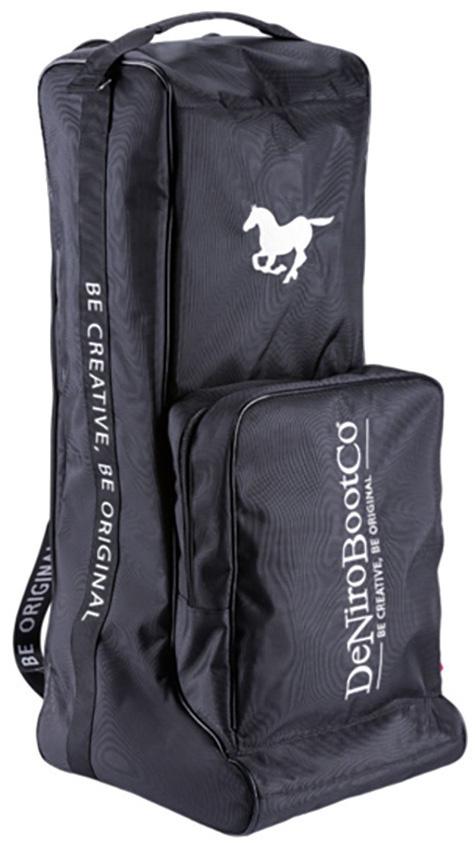

The DeNiro Tall Boot Bag is fleece lined for maximum protection. Taller and more spacious than many other boot bags currently on the market, it’s ideal for modern dressage boots with their additional height and tall outer bows. The bag features a soft, protective divider to stop boots rubbing together, a double zip opening for easy access, and spacious pockets to keep your personal items within easy reach.
Delzani Helmet Bags will protect your helmet while in transit or stored in your tack room. Constructed from a custommade 450gm nylon outer shell, the bag interior is insulated, padded and features a zipper around the circumference for easy access. There’s also a large external zippered accessory pocket ideal for keeping your gloves and other bits and pieces secure.
The Active Equine Bridle Bag offers excellent quality and durability and is the ideal solution for bridle storage, or for when you’re on the road. With a protective padded outer, this bridle bag is designed to store up to two bridles and reins. A mesh lower panel reduces the chance of mould developing during long term storage. Crafted with a durable outer fabric and a reliable YKK zip, it’s super easy to use and ensures your tack stays neat, tidy, and clean.
Made from quilted, padded 600 denier material, the Conrad Saddle Carry Bag Is perfect for protecting your saddle. The bag is designed with convenience and comfort in mind with a removable shoulder strap, as well as a short handle to allow for easy carrying. The waterresistant outer material will protect your valuable saddle from the elements, while the interior padding provides additional cushioning. Spacious and easy to use, generous zips provide easy access to your saddle.





With room to grow and potential aplenty, 120 Hermitage Road, Kurrajong Hills NSW is a dream come true.
Set on 10 fully fenced acres in the picturesque Kurrajong Hills, this well-appointed property is ideal for the equestrian enthusiast. Enjoy a peaceful rural lifestyle with quality equestrian infrastructure already in place, plus the flexibility to personalise the property at your own pace.
The main residence is spacious, practical
and ideal for entertaining. With multiple living areas, and a welcoming familyfriendly layout perfect for relaxed rural living, there's a central kitchen with walkin pantry, dual electric ovens, a bar with black marble bench, and an underground cellar
The open-plan living and dining spaces overlook a charming courtyard and an

enclosed indoor pool and spa area, which doubles as a gym or entertainment space ideal for year-round use. The formal lounge and dining rooms open onto a full-length verandah, and four bedrooms plus a study (or optional fifth bedroom) make this the ideal family home.
The property offers ample room for float or truck parking, along with feed and tack
There are 17 large stables, a wash bay, round yard, and 14 self-watering paddocks and shelters.


storage, and the overall layout ensures functionality for both recreational and light professional use. Whether you're agisting horses or training, this setup allows you to step straight in without the cost of starting from scratch. There are 17 large stables, a wash bay, 10 cleared and fully fenced acres with 14 self-watering paddocks and shelters. There’s a 16m

round yard, a 25 x 25m indoor arena and 25 x 56m outdoor arena (both with Soiltex surfaces and mirrors).
If you've been dreaming of a move to acreage with equestrian facilities already established, this is the one for you! There's ample room for 10 or more horses, a covered small truck and float area, and a large storage shed - and
with the capacity to store 175,000 litres of water, plus a 72 panel solar system, this is a genuine lifestyle property with enormous potential to generate multiple income streams.

Visit the property listing, or call Ray White Kurrajong's Katherina KostrzakAdams on 0410 648 503 to arrange an inspection.






